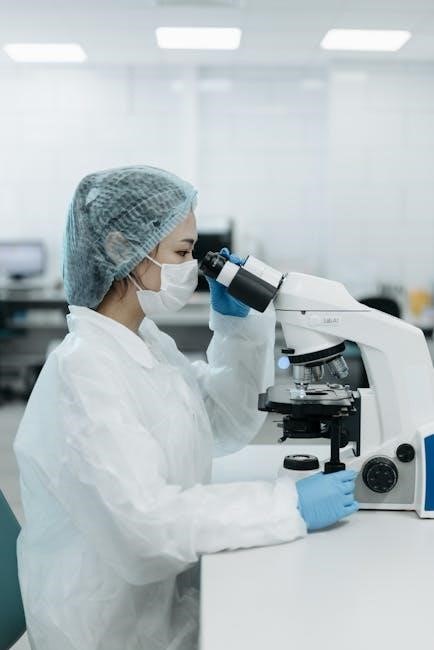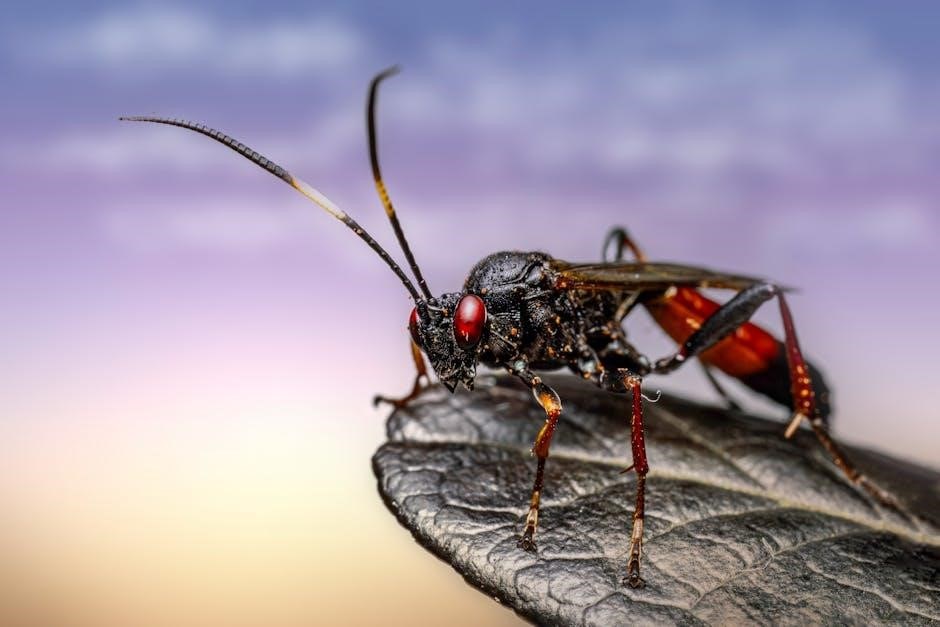biology eoc study guide answer key
Stressed about the Biology EOC? Relax! This study guide answer key is your secret weapon to conquer the test and boost your score. Get ready to ace it!
This section provides solutions and explanations for practice questions related to the Biology End-of-Course exam․ It will include detailed answers‚ reinforcing key concepts from cell biology to genetics and ecology․ This ensures a solid understanding of tested material and improves test-taking skills․
Overview of the Biology EOC Exam
The Biology End-of-Course (EOC) exam is a crucial assessment designed to evaluate a student’s comprehension of essential biology concepts․ This exam typically covers a broad range of topics‚ from the intricacies of cell structure and function to the complexities of genetics‚ heredity‚ evolution‚ and ecological systems․ Understanding the format and content is paramount for effective preparation․
The EOC exam often consists of multiple-choice questions‚ testing not only factual recall but also the ability to apply biological principles to solve problems and interpret data․ Students will encounter questions assessing their understanding of the scientific method‚ experimental design‚ and data analysis․ Time management is crucial‚ as students have a limited time to complete the test․
The exam is administered via computer‚ featuring between 60 and 66 questions with a short break in the middle; Familiarizing oneself with the exam’s structure and content is a vital first step․ This overview serves as a roadmap‚ highlighting the key areas of focus and providing a foundation for more detailed study․
Key Biology Concepts for Review
Preparing for the Biology EOC exam requires a thorough review of fundamental biological principles․ Core concepts include cell structure and function‚ emphasizing organelles‚ their roles‚ and cellular processes like osmosis and diffusion․ Genetics and heredity are crucial‚ encompassing DNA structure‚ gene expression‚ Mendelian genetics‚ and inheritance patterns․ Understanding evolution and natural selection is also essential․
Ecology and ecosystems form another key area‚ covering topics such as food webs‚ energy flow‚ nutrient cycles‚ and interactions between organisms․ Bioenergetics‚ including photosynthesis and cellular respiration‚ is vital for understanding how energy is captured and utilized by living organisms․ Familiarity with the scientific method is also necessary․
Additionally‚ students should review basic biochemistry‚ including the structure and function of carbohydrates‚ lipids‚ proteins‚ and nucleic acids․ Grasping these key concepts provides a solid foundation for tackling EOC exam questions․ Effective review strategies‚ practice questions‚ and a focus on understanding rather than memorization will maximize success․
Cell Structure and Function
Understanding cell structure and function is foundational to biology․ Cells‚ the basic units of life‚ have various organelles performing specific tasks․ The nucleus houses DNA‚ controlling cell activities․ Ribosomes synthesize proteins‚ essential for cell structure and function․ The endoplasmic reticulum (ER) assists in protein and lipid synthesis‚ with the rough ER containing ribosomes․
The Golgi apparatus modifies‚ sorts‚ and packages proteins․ Mitochondria generate energy through cellular respiration‚ while chloroplasts conduct photosynthesis in plant cells․ Lysosomes break down waste materials․ The cell membrane‚ composed of a lipid bilayer‚ regulates the movement of substances in and out of the cell․
Cellular processes like osmosis and diffusion facilitate transport across the membrane․ Understanding these components and their functions is crucial․ Cell theory states that all living things are composed of cells‚ cells are the basic units of structure and function in living things‚ and new cells are produced from existing cells․ These fundamental concepts are essential for success․

Genetics and Heredity
Genetics and heredity explore how traits are passed from parents to offspring․ DNA‚ the molecule of heredity‚ contains genes that code for specific traits․ Gregor Mendel’s experiments with pea plants laid the foundation for understanding inheritance patterns․ Dominant alleles mask recessive alleles‚ influencing phenotype expression․
Genotypes represent the genetic makeup‚ while phenotypes describe observable characteristics․ Punnett squares predict offspring genotypes and phenotypes․ Meiosis‚ a type of cell division‚ produces gametes with half the number of chromosomes․ Genetic mutations can introduce variations in traits․ Understanding concepts like codominance‚ incomplete dominance‚ and sex-linked traits is crucial․
Molecular genetics focuses on gene expression and regulation․ Transcription and translation are key processes in protein synthesis․ Epigenetics explores how environmental factors can influence gene expression․ Genetic engineering and biotechnology have revolutionized medicine and agriculture․ Familiarity with these topics is essential for the Biology EOC‚ ensuring students grasp inheritance principles and molecular mechanisms․
Evolution and Natural Selection
Evolution and natural selection explain how life changes over time․ Natural selection‚ proposed by Charles Darwin‚ suggests organisms with advantageous traits are more likely to survive and reproduce․ This leads to adaptation and the development of new species․ Evidence for evolution includes fossil records‚ comparative anatomy‚ and molecular biology․
Genetic variation within populations is essential for natural selection․ Mutations and sexual reproduction introduce new traits․ Gene flow‚ genetic drift‚ and non-random mating can also influence allele frequencies․ Speciation‚ the formation of new species‚ can occur through various mechanisms‚ such as geographic isolation and reproductive isolation․
Understanding the concepts of homologous and analogous structures helps to trace evolutionary relationships․ Phylogenetic trees illustrate the evolutionary history of organisms․ Microevolution refers to small-scale changes in allele frequencies‚ while macroevolution involves larger-scale evolutionary changes․ A thorough grasp of evolutionary principles is vital for the Biology EOC‚ enabling students to comprehend the diversity and interconnectedness of life․
Ecology and Ecosystems

Ecology is the study of interactions between organisms and their environment․ Ecosystems are communities of living organisms (biotic factors) interacting with their non-living environment (abiotic factors)․ Key abiotic factors include sunlight‚ water‚ temperature‚ and nutrients․ Biotic interactions involve competition‚ predation‚ symbiosis‚ and mutualism․ Populations‚ communities‚ and ecosystems are organized hierarchically․
Energy flows through ecosystems via food chains and food webs․ Producers‚ like plants‚ capture sunlight through photosynthesis․ Consumers‚ such as herbivores and carnivores‚ obtain energy by eating other organisms․ Decomposers break down dead organic matter‚ recycling nutrients back into the ecosystem․ Trophic levels represent the position of an organism in a food chain․
Nutrient cycles‚ including the carbon‚ nitrogen‚ and water cycles‚ are crucial for maintaining ecosystem health․ Human activities‚ such as deforestation and pollution‚ can disrupt these cycles and negatively impact ecosystems․ Understanding ecological concepts is essential for the Biology EOC‚ enabling students to analyze environmental issues and propose sustainable solutions․ Studying pioneer species‚ climax communities‚ and ecological succession is also important․
Bioenergetics (Photosynthesis and Cellular Respiration)

Bioenergetics explores energy flow in living organisms‚ focusing on photosynthesis and cellular respiration․ Photosynthesis‚ carried out by plants and some bacteria‚ converts light energy into chemical energy (glucose)․ This process occurs in chloroplasts‚ utilizing chlorophyll to capture sunlight․ Carbon dioxide and water are converted into glucose and oxygen․
Cellular respiration breaks down glucose to release energy in the form of ATP (adenosine triphosphate)․ This process occurs in mitochondria and involves glycolysis‚ the Krebs cycle‚ and the electron transport chain․ Both aerobic (with oxygen) and anaerobic (without oxygen) respiration exist․ Aerobic respiration yields significantly more ATP than anaerobic respiration․
ATP is the primary energy currency of cells‚ powering various cellular activities․ The relationship between photosynthesis and cellular respiration is crucial for life on Earth․ Photosynthesis produces glucose and oxygen‚ which are then used in cellular respiration to produce ATP‚ carbon dioxide‚ and water․ Understanding these processes is vital for the Biology EOC‚ including enzyme functions and activation energy․
Effective Study Strategies and Resources
Preparing effectively for the Biology EOC requires a strategic approach and utilization of diverse resources․ Begin by familiarizing yourself with the exam format and content‚ focusing on key biology concepts․ Create a study schedule‚ allocating specific time slots for different topics like cell structure‚ genetics‚ evolution‚ and ecology․
Employ active learning techniques such as flashcards‚ practice questions‚ and concept mapping to reinforce understanding․ Utilize online resources like review videos‚ interactive quizzes‚ and study guides to supplement textbook learning․ Collaborate with peers through study groups to discuss challenging concepts and share insights․

Practice with official Biology EOC practice tests to simulate exam conditions and identify areas for improvement․ Pay attention to feedback and explanations for incorrect answers․ Focus on understanding the reasoning behind correct answers․ Manage time effectively during the exam by pacing yourself and prioritizing questions․ Ensure adequate rest and nutrition to optimize cognitive function during study sessions and the exam․
Practice Questions and Answer Explanations
This section offers a series of practice questions designed to mirror the format and content of the Biology EOC exam․ Each question is followed by a detailed explanation of the correct answer‚ providing insights into the underlying biological principles and reasoning․ These practice questions cover a range of topics‚ including cell biology‚ genetics‚ evolution‚ and ecology․
The goal is to provide students with opportunities to apply their knowledge and develop problem-solving skills․ By working through these practice questions and reviewing the answer explanations‚ students can identify their strengths and weaknesses․ This approach allows them to focus their study efforts on areas where they need the most improvement․
Furthermore‚ the answer explanations provide a deeper understanding of the concepts tested‚ reinforcing learning and promoting retention․ These questions aim to prepare students thoroughly for the Biology EOC exam by familiarizing them with the types of questions they can expect and equipping them with the tools to approach them confidently․

